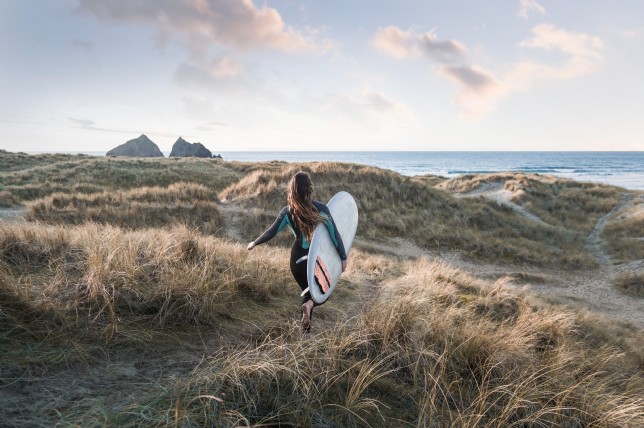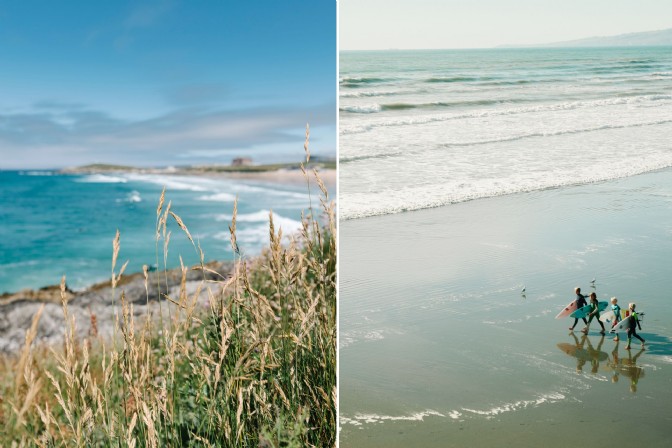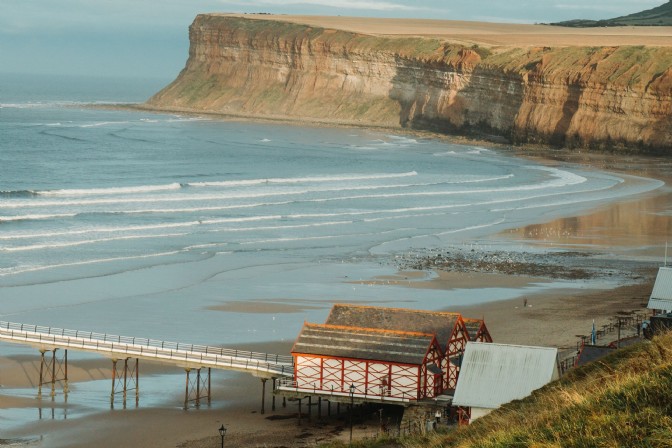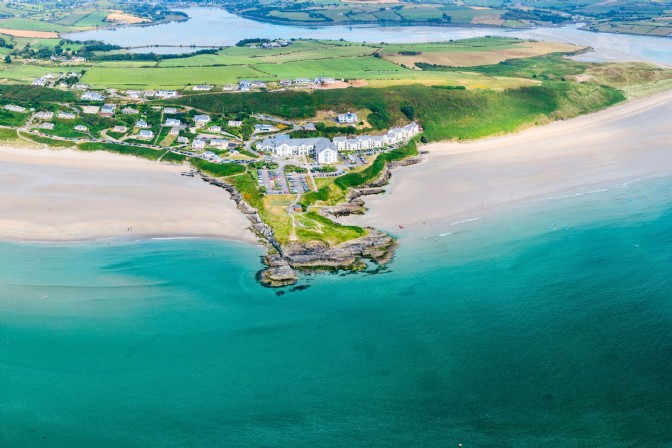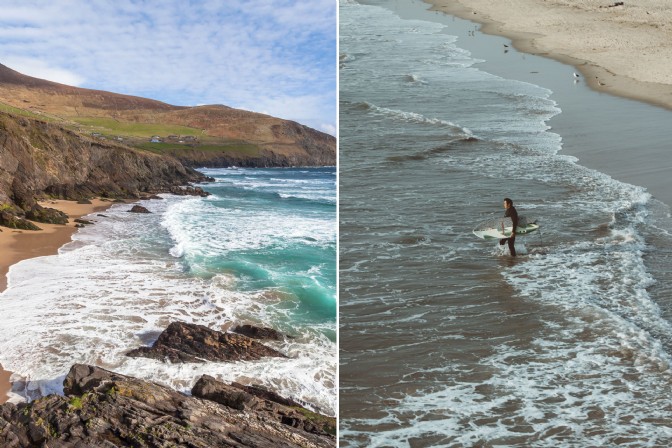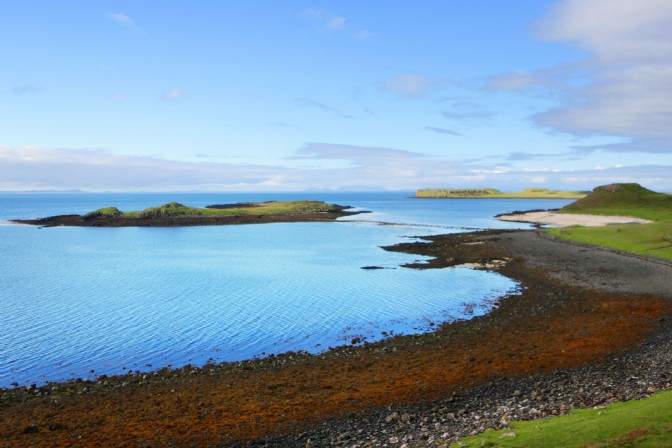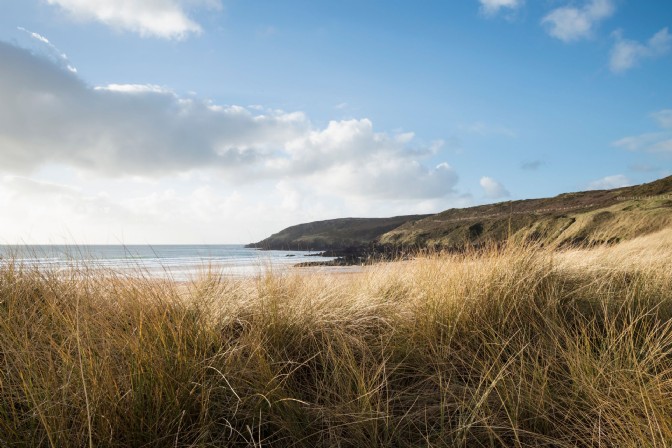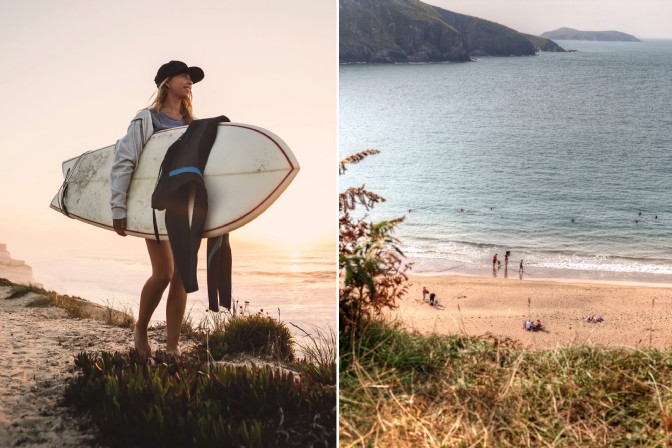Surfing nirvana needn't be confined to far-flung destinations. Whether a seasoned boarder or a born-again “grommet”, surf holidays on home soil know how to pack a punch (and still stay under the radar). Unperturbed by mizzle and thick neoprene, a wild wave-riding revolution is unfolding on our own shores... and we know the spots that are stealing the show. Here, we round up our choice of the best surfing beaches in the UK and Ireland (and where to stay for a luxury break).
Sure, there are national championships, floodlit night surfs, and music festivals with a side of extreme sports culture. But paddle out a little further, and you’ll find uncrowded islands with tight-knit local surf scenes, coastal towns that combine the physicality of surfing with the holistic approach of meditation, and out-and-out natural phenomena that bring two-metre waves to inland rivers. Think of it as the North Atlantic’s most humble retort to Bondi.
England
On the radar: Fistral Beach, Cornwall
Widely recognised as one of the finest surf spots in the UK, Fistral Beach attracts surfers from world-over. Known for its ingrained surf culture, consistent waves, and cornucopia of surf schools, Newquay earned its spot as the host of Boardmasters and The Night Surf. Its famed reef break - The Cribbar - produces some of the most powerful swells in Cornwall, enticing spectators to gather on the Towan Headland to watch as professional surfers tackle up to 40ft waves, while beginners stick to the safety of shallow ankle-slappers.
When to go: Year-round, with peak surf season and bigger waves between September and November, and warmer weather (but more crowded beaches) between May and August.
Where to stay: Newquay, Mawgan Porth, or Crantock
On the radar: Porthleven, Cornwall
This small village near Helston on the south coast of Cornwall offers a reef break with consistent surf, particularly during the winter months. A favourite with professionals pursuing hollow waves, and perhaps the occasional barrel, Porthleven has a grassroots surfing community made up of many of the current generation of British pros. Beginners might want to sit this one out: its barnacle encrusted reef is a painful landing spot. With all sorts of eateries celebrating the rich culinary heritage of Cornwall, there's plenty of places to down fibreglass and feast on pasties and saffron cakes while the experts make their mark.
When to go: Year-round, with increased swells and decreased crowds between September and November, and milder, but busier, beaches between May and August.
Where to stay: Porthleven
On the radar: Gwithian, Cornwall
A peaceful, laidback beach on the west coast of Cornwall, Gwithian is marked by mellow rides, steeper faces, the occasional barrel, and plenty of space to spread out and find your own peak. Come here for unpretentious family surfing holidays, where silver-studded blue butterflies and rock pools offer respite from the water, and artsy vibes flutter in from St Ives. Consistent Atlantic surges make it a reliable spot, and the beach is exposed to a broad stretch of coastline, so there's always a good chance of finding rideable waves. Plus, its beach break makes it appealing for beginners looking for a soft landing.
When to go: Year-round, with consistent surf and less visitors between September and November, and warmer (and more crowded) waters between May and August.
Where to stay: Gwithian or St Ives
Under the radar: Saltburn-by-the-Sea, Yorkshire
Up in North Yorkshire, there's a place where challenging waves and midwinter swells live alongside Sunday puddings and carefully brewed black tea. A place known for its Victorian pier and charming cliffside tramway, Saltburn-by-the-Sea beckons advanced surfers seeking the dynamic waves that only exposure to the North Sea allows. As is so often the case in the north, the surf community here is all about camaraderie, so experienced visitors are always welcome. And whilst it's admired in surf circles, it generally benefits from less crowded line-ups than the rest of the UK.
When to go: Year-round, with the largest swells between September and November, and opportunities for spring and summer learners between May and August.
Where to stay: Yorkshire
Under the radar: The Severn Bore, Gloucestershire
A natural phenomenon that occurs on the River Severn in Gloucestershire, the Severn Bore happens when a potent tidal wave travels upstream against the current, creating a rare inland surfing experience. Its long, peeling waves and faster, steeper sections attract surfers from world-over, but its size, speed, and dynamic conditions mean it is generally not recommended for beginners. Expect to find the third highest tidal range in the world, some of the longest rideable waves, and dozens of competitors vying to set new records in the birthplace of river surfing.
When to go: From August to October, and January to April, when tidal conditions create the bores. The biggest bores happen during the equinoxes, but smaller ones occur year-round. There are approximately 260 bores each year, happening twice daily for 130 days.
Where to stay: Gloucestershire or The Cotswolds
Ireland
On the radar: Inchydoney Beach, County Cork
Near Clonakilty in County Cork, Inchydoney is one of Ireland's iconic surfing beaches. Separated from the mainland by a shallow channel, forming a natural amphitheatre-like setting, its configuration helps to funnel and shape incoming swells, creating quality waves. Compared to many other surf spots in Ireland, Inchydoney benefits from the influence of the Gulf Stream, resulting in relatively warm waters. The presence of seals and dolphins adds a wild touch to this pristine shoreline, which still retains the feel of expeditionary surfing.
When to go: Year-round, with the peak season for surfing falling between September and November, and more pleasant temperatures between May and August.
Where to stay: County Cork
On the radar: Inch Beach, County Kerry
A renowned stretch of sandy coastline and a Blue Flag beach, Inch attracts surfers, swimmers, and kiteboarders to revel beneath the Dingle Peninsula. Stretching for four miles and exposed to Atlantic surges, it's best suited to surfers pursuing challenging waves, or those wanting to catch a glimpse of the pros competing at national and international surfing competitions.
When to go: Year-round, with good surf conditions and relatively mild weather between September and November, and milder weather between May and August.
Where to stay: County Kerry
Under the radar: Garretstown Beach, County Cork
A hidden gem that often flies under the radar, Garretstown Beach near Kinsale in County Cork offers a secluded and uncrowded surf experience, especially outside of peak seasons. Well-regarded for its consistent waves and suitability for all skill levels, it benefits from a southwest-facing aspect that allows it to pick up swells from the Atlantic Ocean. There's beach breaks, reef breaks, and surf schools with rentals available, making it simple for out-of-towners to pick up where they left off. This place glows in the golden hour, and intriguing tide pools will keep the non-surfers entertained.
When to go: Year-round, with good surf conditions and moderate crowds between September and November, and longer daylight hours between May and August.
Where to stay: County Cork
Under the radar: Coumeenole Beach, County Kerry
Ireland may have relinquished its status as surfing's best-kept secret, but Coumeenole Beach sticks fast at the surfing frontier. An obscure spot on the Dingle Peninsula in County Kerry, it has spirited waters that call for experienced surfers. Exposed and challenging, its remote coordinates add to the appeal of those tailing a more adventurous and authentic surfing experience.
When to go: Year-round, with favourable surf conditions and milder weather between September and November, and more comfortable weather between May and August.
Where to stay: County Kerry
The Hebrides, Scotland
On the radar: Luskentyre Beach, Isle of Harris
Come here for cornstarch sands and turquoise waters. The best-known beach in the Outer Hebrides, Luskentyre looks more like the Caribbean than the Scottish Isles. What it lacks in consistent and sizable waves, it makes up for in expeditionary feel and good learning opportunities for beginners; but on those rare occasions when weather patterns produce impressive swell, experienced surfers will find themselves among the upper echelon of Scotland's surf community. Try your hand at windsurfing or kiteboarding if all else fails, but look out for the cold water temperatures and strong currents.
When to go: Year-round, with better chances (and less visitors) between September and February, and milder weather between June and September.
Where to stay: Luxury homes on the Isle of Harris
Under the radar: Claigan Coral Beach, Isle of Skye
Somewhat of an atypical surf spot, Claigan Coral Beach can occasionally produce small waves that are suitable for beginners or long boarders. The beach is better known for its unique coral-like formations and "ends of the earth" scenery than it is for reliable swell, with large waves happening only occasionally. Nevertheless, professional surfers seeking respite from the buzz of world-class waves might still bring their board to the Isle of Skye on the off chance that once in a lifetime surf conditions arise in the Outer Hebrides. Plus, it's widely considered the best wild swimming spot on the isle.
When to go: Year-round, with small waves (and smaller crowds) between September and February, and warmer temps between May and August.
Where to stay: Luxury homes on the Isle of Skye
Wales
On the radar: Freshwater West, Pembrokeshire
As cinematic a surf beach as you'll find in the "land of song", the poetic seascapes at Freshwater West have earned it features in films like Harry Potter and the Deathly Hallows and Robin Hood. Known for its robust waves and consistent surf conditions, it's a favourite amongst experienced surfers. Wide and sandy, with impressive dunes and cliffs adding to its dramatic appeal, Freshwater West has strong currents and rips that make it a no-go for beginners. There's a vibrant surf culture here, with a community of dedicated locals and visiting enthusiasts bringing an easygoing atmosphere to the line up.
When to go: Year-round, with reliable surf conditions and fewer visitors between September and November, and opportunities for longer sessions without feeling the intense cold between May and August.
Where to stay: Pembrokeshire
Under the radar: Mwnt, Ceredigion
Tucked away along the Ceredigion coastline, Mwnt is a covert beach with unpredictable surf, capable of producing great waves when the conditions align... or mere ripples when they don't. But according to local folklore, Mwnt was believed to be the home of mermaids and sea monsters, making it a charming destination for family surfing holidays where storytelling and connection to the heritage of the land takes precedence over the consistency of the swell.
When to go: Year-round, with good surf conditions and smaller crowds between September and November, and a steady stream of warmer waves between May and August.
Where to stay: Ceredigion
